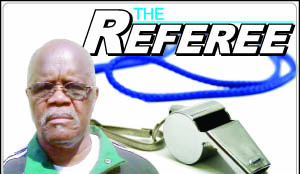 Preamble:
Preamble:
I WISH to draw the attention of the followers of this column that in accordance with the sequence of this column, Law 4: The Players’ equipment, was to be carried in two parts. Parts one and two were arranged as episodes three and four, respectively.
The Sunday Times of Zambia October 20, 2013 edition covered part one of Law 4, while part two which should have been carried in the following edition of October 27, 2013 skipped part two and carried Law 5: The Referee instead.
Therefore, it is imperative that today I revert to Law 4 and finish explaining the fine part of this Law.
As I stated in episode three, Law 4 of the game of football deals with the players’ (uniform) equipment. The intention behind Players’ Equipment Law is safety of the players. Hence, for the safety of players, some of the items players may want to use during a match have been outlawed.
To stress the importance of the safety of the players, the equipment that players use during a match is classified as Basic Compulsory i.e. Jersey, Shorts, Stockings, Shinguard and footwear. The basic compulsory equipment used by players was carried in episode three of this column.
Notwithstanding, in addition to the basic compulsory equipment, there are other modern protective equipment allowed to be used by players and this is what today’s edition will deal with in great details.
The fact is that some people who may desire to play football have different physical disabilities which may include injuries which are picked during matches.
In order to provide for this group of players with equipment that enables them to play the game, other equipment have been devised and allowed to be used by such players.
In this light, the Law provides that “a player may use equipment other than the basic equipment provided that its solo purpose is to protect him physically and it poses no danger to him or any other player.”
Basic Equipment:
Colours:
* If the jerseys of the two goal-keepers are the same colour and neither has another jersey to change into, the Referee allows play to begin.
If a player loses his footwear (boot) accidentally and immediately plays the ball and/or scores a goal, there is no infringement and the goal is awarded because he lost his footwear by accident.
Goal-keepers may wear tracksuit bottoms as part of their basic equipment.
Other Equipment:
A player may use equipment other than the basic equipment provided that its sole purpose is to protect him physically and it poses no danger to him or any other player.
All items of clothing or equipment other than the basic equipment must be inspected by the referee and determined not to be dangerous.
Modern protective equipment such as headgear, facemasks and knee and arm protectors made of soft, lightweight padded material are not considered dangerous and are therefore permitted.
In view of the new technology that has made sports spectacles much safer, both for the wearer and for other players, referees should show tolerance when authorizing their use, particularly for young players.
If an item of clothing or equipment that has been inspected at the start of a match and determined not to be dangerous becomes dangerous or is used in a dangerous manner during the match, its use must no longer be allowed.
The use of electronic communication system between players and/or technical staff is not permitted.
Jewellery:
All items of jewellery (necklaces, rings, bracelets, earrings, leather bands, rubber bands etc) are strictly forbidden and must be removed. Using tape to cover jewellery is not acceptable.
Referees and assistant referees including the 4th Official are also prohibited from wearing jewellery (except for a watch or similar device for timing the match).
Disciplinary Sanctions:
Players must not reveal undershirts which contain slogans or advertising. If a player reveals undershirt which contains slogans or advertising when celebrating a goal, etc:
* No disciplinary action on the field of play.
* Referee reports the incident to the appropriate authorities for sanctions.
If a player removes his jersey over his head or covering his head with a jersey when celebrating a goal:
* He must be cautioned.
The players are to be inspected before the match begins and substitutes before they enter the field of play. If a player is discovered to be wearing unauthorized clothing or jewellery during play, the referee must:
* Inform the player that the item in question must be removed.
* Order the player to leave the field of play at the next stoppage if he is unable or willing to comply.
* Caution the player if he willfully refuses to comply or, having been told to remove the item, is discovered to be wearing the item again.
If play is stopped to caution the player, an indirect free-kick must be awarded to the opposing team from the position of the ball when play was stopped, unless play was stopped inside the goal-area, in which case the kick is taken on the goal-area line parallel to the goal-line at a point nearest where the ball was located when play was stopped.






